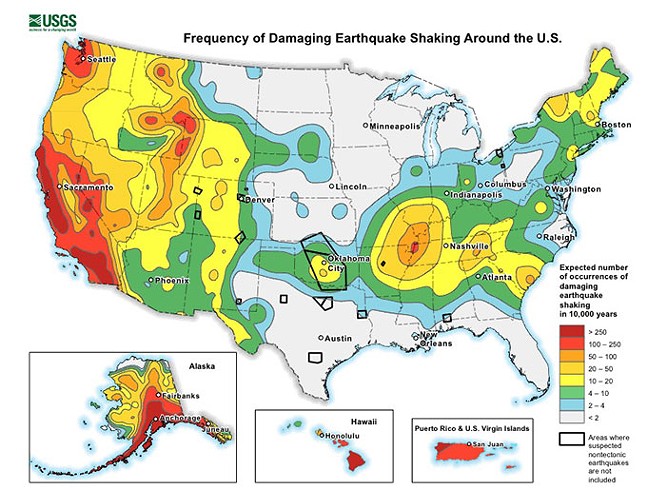When a 5.8 magnitude earthquake hit northern Virginia in 2011, the Pittsburgh area felt the tremors. It shook not only some Pittsburgh buildings, but some residents’ psyches. As far as many were concerned, earthquakes didn't seem like something that could happen in Pittsburgh.
And while naturally occurring earthquakes in the United States are rare outside of the West Coast and Pacific states like Hawaii and Alaska, there are other kinds of earthquakes, referred to as "induced seismicity," that regions far from fault lines are susceptible to.
Induced earthquakes refer to seismic activity caused by human activity, such as wastewater disposal related to natural-gas drilling ("fracking"). Shaking can result from the process of expelling high-pressure liquid deep into the earth’s surface. These induced seismicity earthquakes have been documented in Oklahoma and Ohio. The Pittsburgh area has experienced a high volume of fracking over the last several years, but has yet to experience any major induced seismicity earthquakes. And natural-gas drilling could likely increase thanks to the creation of the cracker plant in Beaver County, which will refine the gas extracted by fracking wells.
With natural earthquakes a rare possibility and a likely growing increase in fracking, what are the chances of Pittsburgh experiencing more tremors in the future?
Thomas Pratt, a research geophysicist at the United States Geological Survey, says it is difficult to determine since the Pittsburgh region hasn’t been extensively studied, tectonically speaking. However, he says geologists don’t tend to rule things out.
“I [shouldn't] say you should never be concerned about earthquakes,” says Pratt.
But, of what has been studied, the Pittsburgh region has an extremely low probability of damaging seismic activity from natural causes. According to a 2014 USGS map, the area around Pittsburgh is expected to get less than two damaging earthquakes in 10,000 years. For comparison, coastal sections of California are expected to get more than 250 damaging earthquakes in that time span and even Northeastern Ohio is expected to get between four and 10.
Pratt says the East Tennessee seismic zone — about 300 or so miles south of Pittsburgh — is relatively active, as far as eastern U.S. seismic zones go. It has the potential to produce an earthquake with a magnitude near 7.0, but that has never been recorded.
As for the Appalachian Mountains seismic potential, Pratt says it is still mainly a mystery to geologists. In fact, the mountains themselves are generally a mystery to experts, so their seismology is even harder to determine.
“[Earthquakes] are likely related when you have an active mountain belt. That’s the tectonic process that creates the mountains,” says Pratt. “The Appalachian Mountains are a bit of mystery because they actually should have eroded away by now.”
But now that natural-gas drilling is booming in the area, what about induced seismicity earthquakes?
According to a 2016 Canadian study published in the journal Science, fracking has been known to cause minor earthquakes. The USGS says that fracking itself is an extremely small player in induced seismicity, but the disposal of the wastewater deep into the ground (a by-product of fracking) is a more common cause for shaking.
Southwestern Pennsylvania has been extremely active in natural-gas drilling with thousands of wells drilled across the region over the years, especially concentrated in Washington and Greene counties. However, a 2018 report from the Pennsylvania Department of Environmental Protection states that 90 percent of wastewater is recycled in Pennsylvania and only 7 percent were disposed of in the method that is linked to induced seismicity.
Concerns about induced seismicity earthquakes have spread to eastern Ohio since natural-gas drilling and wastewater disposal has increased there, but those concerns haven't really surfaced in the Pittsburgh area.
Pratt says an April earthquake in Northeastern Ohio wasn’t fracking-related, but the USGS does believe areas east of there — where many fracking wells are located and wastewater disposal is occurring — are having induced seismicity events.
As for the Pittsburgh area, with its large quantity of fracking wells, Pratt says the lack of seismic activity induced by natural-gas drilling could be the result of a number of factors. He says the types of rocks beneath the region are much older and much more solid than other areas. He says it could also be that area fracking companies are using a different technique to cut down on potential earthquakes. Pennsylvania fracking companies are recycling the majority of their wastewater, for instance.
“It may be different in the way the fracking is done or in the stress put into the crust, we just don’t know,” says Pratt.
Editor’s note: Some of the language in this article has been altered from its original version to better reflect how induced seismicity earthquakes in America have been primarily caused by wastewater disposal, a by-product from fracking, not the drilling process itself.
















